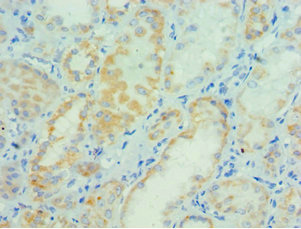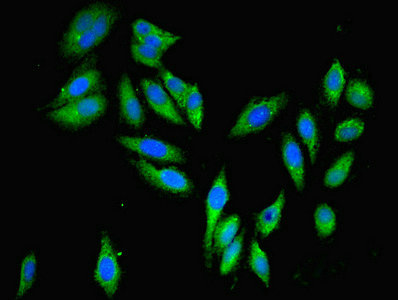![Western blot All lanes: Poly [ADP-ribose] polymerase 3 antibody at 7ug/ml + Mouse kidney tissue Secondary Goat polyclonal to rabbit IgG at 1/10000 dilution Predicted band size: 60 kDa Observed band size: 60 kDa Western blot All lanes: Poly [ADP-ribose] polymerase 3 antibody at 7ug/ml + Mouse kidney tissue Secondary Goat polyclonal to rabbit IgG at 1/10000 dilution Predicted band size: 60 kDa Observed band size: 60 kDa](https://www.cusabio.com/uploadfile/antibody/6/CSB-PA017467ESR2HU-WB.jpg)
Western blot All lanes: Poly [ADP-ribose] polymerase 3 antibody at 7ug/ml + Mouse kidney tissue Secondary Goat polyclonal to rabbit IgG at 1/10000 dilution Predicted band size: 60 kDa Observed band size: 60 kDa
PARP3 Antibody
CSB-PA017467ESR2HU
ApplicationsImmunoFluorescence, Western Blot, ELISA, ImmunoHistoChemistry
Product group Antibodies
ReactivityHuman, Mouse
TargetPARP3
Overview
- SupplierCusabio
- Product NamePARP3 Antibody
- Delivery Days Customer20
- ApplicationsImmunoFluorescence, Western Blot, ELISA, ImmunoHistoChemistry
- CertificationResearch Use Only
- ClonalityPolyclonal
- ConjugateUnconjugated
- Gene ID10039
- Target namePARP3
- Target descriptionpoly(ADP-ribose) polymerase family member 3
- Target synonymsADP-ribosyltransferase (NAD+; poly (ADP-ribose) polymerase)-like 2; ADP-ribosyltransferase (NAD+; poly (ADP-ribose) polymerase)-like 3; ADP-ribosyltransferase diphtheria toxin-like 3; ADPRT3; ADPRT-3; ADPRTL2; ADPRTL3; ARTD3; DNA ADP-ribosyltransferase PARP3; IRT1; NAD(+) ADP-ribosyltransferase 3; NAD+ ADP-ribosyltransferase 3; PADPRT-3; poly [ADP-ribose] polymerase 3; poly(ADP-ribose) synthetase-3; poly[ADP-ribose] synthase 3; poly[ADP-ribose] synthetase 3; protein mono-ADP-ribosyltransferase PARP3
- HostRabbit
- IsotypeIgG
- Protein IDQ9Y6F1
- Protein NamePoly [ADP-ribose] polymerase 3
- Scientific DescriptionInvolved in the base excision repair (BER) pathway, by catalyzing the poly(ADP-ribosyl)ation of a limited number of acceptor proteins involved in chromatin architecture and in DNA metabolism. This modification follows DNA damages and appears as an obligatory step in a detection/signaling pathway leading to the reparation of DNA strand breaks. May link the DNA damage surveillance network to the mitotic fidelity checkpoint. Negatively influences the G1/S cell cycle progression without interfering with centrosome duplication. Binds DNA. May be involved in the regulation of PRC2 and PRC3 complex-dependent gene silencing.
- ReactivityHuman, Mouse
- Storage Instruction-20°C or -80°C
- UNSPSC12352203


